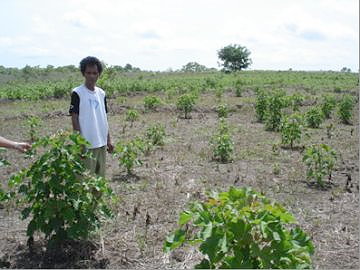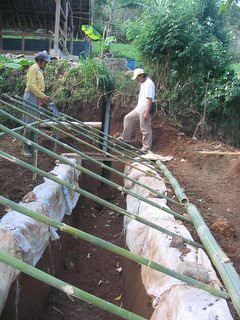
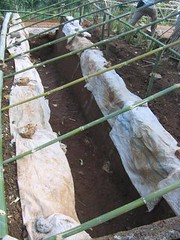
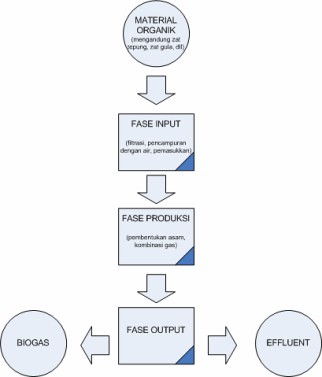

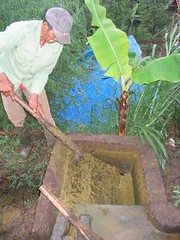
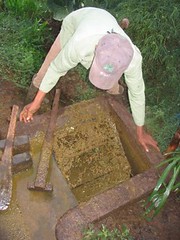
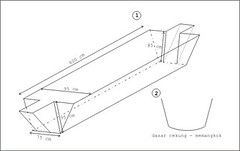
Infrastructure Pembangkit biogas - PART1
oleh: echo (unjoin at gmail dot com) document, version 1.0 - October 15, 2005
Copyright (c) 2005 by ECHO (unjoin at gmail dot com). This material May be distributed only subject to the terms and conditions set out in the Open Publication License, v1.0 1999 or later (the latest version is currently available at http://www.opencontent.org/openpub/).
The distribution of a work or other derivative work in any standard (paper) book form is prohibited unless prior permission is obtained from the copyright holder. "
1. PENDAHULUAN
Ketika seseorang berbicara mengenai biogas, yang biasanya gas dimaksud adalah yang dihasilkan oleh prose biologis yang anaerob (tanpa bersentuhan dengan oksigen free) Yang terdiri Dari kombinasi methane (CH4), karbon dioksida (CO2), Air dalam bentuk UAP (H20), dan beberapa lain seperti hidrogen sulfida gas (H2S), nitrogen gas (N2), hidrogen gas (H2) dan jenis gas Other dalam jumlah kecil.
Secara lebih singkat, biogas should diartikan sebagai gas yang diproduksi oleh makhluk hidup. "
Dalam article penulis serious pertama ini tidak akan menceritakan mengenai konsep konsep yang melatarbelakangi biogas secara mendalam untuk menghindari terlihat seperti text-book). Akan tetapi Disini penulis akan menceritakan this mendokumentasikan experience penulis mengenai pembuatan this instalasi pembangkit (autoclave) biogas di agricultural area Manglayang yang menggunakan Bahan Baku kotoran sapi seperti yang telah penulis lakukan.
Pembangkit yang kami Buat adalah pembangkit biogas terbuat Dari tubular plastic polyethylene dengan kind pembangkit horizontal continuous feed, biasa disebut juga kind plug-flow, atau terkadang disebut juga sebagai model Vietnam karena dikembangkan terakhir disana.
Pertimbangan kami mengadopsi kind ini Adalah: a. Biaya on rendah B. Instalasi on mudah C. Bahan Serta alat yang digunakan should ditemukan di sekitar kota Bandung.
Ada kind pembangkit biogas banyak yang telah diciptakan this dikembangkan. No Dari kurang Kolombia, Etiopia, Tanzania, Vietnam now Kamboja telah mengembangkan pembangkit dengan harga murah, dengan tujuan utama mereduksi biaya produksi dengan menggunakan Bahan Bahan Baku proposed yang di lokal this instalasi this prose Operasi yang sederhana. (Botero this preston 1987; Solarte 1995; Chater 1986; Sarwatt et al 1995; Soeurn 1994; Khan, 1996).
Model digunakan ini yang Dari berbasis model "red mud PVC" yang dikembangkan oleh Taiwan seperti dijelaskan oleh Pound et al (1981) yang lebih kemudian oleh disederhanakan Preston always present kawan kawan untuk kali pertama di Etiopia (Preston unpublished.), Dan Kolombia (Botero this Preston 1987) this terakhir dikembangkan di Vietnam (Bui Xuan An et al 1994).
Tujuan utama kami melakukan instalasi pembangkit biogas Manglayang di agricultural area adalah bukan pencapaian produksi gas maksimal yang. Namun selain sebagai prose pembelajaran Technology, juga untuk mendapatkan Hasil keluaran Dari pembangkit biogas yang merupakan pupuk organik kualitas dengan baik.
2. PERSIAPAN Infrastructure PEMBANGKIT
Mari kita lihat konsep dasar Alur prose produksi biogas.
Diagram Alur prose Produksi biogas
Gambar 1: Diagram Alur Proses produksi biogas
Tahapan awal adalah mempersiapkan Bahan Baku organik yang should dicerna oleh bakteri this mikroorganisme yang Canada didalam pembangkit biogas. Dalam hal ini karena instalasi biogas dilakukan di area peternakan sapi perah, Bahan Baku digunakan yang utama adalah kotoran sapi. Perlu diketahui, bahwa apabila yang menjadi tujuan utama Dari instalasi biogas adalah pencapaian produksi gas yang optimal kotoran sapi bukan Bahan Baku yang baik.
Tahap selanjutnya adalah sebut dengan yang kami phase of entry. Di dalam phase ini dilakukan pengolahan terhadap Bahan Baku agar should memenuhi persyaratan yang kami telah tentukan Previous yaitu:
A. Filtrasi pertama.
Public Dari penyaringan ini adalah Bahan Baku mengandung serat yang tidak terlalu Kasar. Serat Kasar Disini berarti sampah sampah atau kotoran Kandang selain kotoran Livestock, seperti batang this daun Keras, sisa batang rumput this kotoran Other sebagian yang besar adalah sisa sisa Pakan Livestock yang terlalu Kasar. Hal ini should menimbulkan foam / buih this residue di dalam pembangkit yang should mengurangi kinerja Dari pembangkit itu sendiri.
B. Pencampuran dengan air this pengadukan.
Dilakukan pencampuran kotoran sapi Dan Air. Air sangat dibutuhkan oleh mikroorganisme di dalam pembangkit sebagai media transport. Oleh karenanya tahapan ini cukup krusial mengingat campuran yang terlalu encer atau terlalu kental should mengganggu kinerja pembangkit this menyulitkan dalam penanganan effluents (Hasil keluaran pembangkit biogas). Sebagai panduan dasar, campuran yang baik berkisar Antara 7% - 9% Bahan padat. Disini juga dilakukan pengadukan agar campuran Bahan organik - air should tercampur dengan homogen.
C. Filtrasi kedua
Public kami melakukan penyaringan tahap dengan kedua untuk adalah memisahkan kotoran sapi sebagai Bahan Baku organik pembangkit dengan yang lain Bahan anorganik Lolos saringan tahap pertama di terutama pasir this batu batu kecil. Proses ini cukup penting mengingat kandungan Bahan anorganik (pasir) tidak di dalam pembangkit should dicerna oleh bakteri this residue should menyebabkan di dasar pembangkit.
D. Pemasukkan Bahan organik
Kami membuat semacam katup / keran sederhana agar prose pemasukkan Bahan organik kedalam pembangkit should dilakukan dengan semudah mungkin.
Memang cukup parameter setting banyak yang perlu diperhatikan dalam pembuatan pembangkit biogas ini (parameter syarat syarat lain seperti Temperatur, rasio karbon - nitrogen, this derajat keasaman Other mudah mudahan should singgung kami di tulisan selanjutnya). Nampaknya hal hal inilah yang menjadi kendala Operasi dalam pemasyarakatan this penggunaan pembangkit biogas secara masal banyak di Negara.
Public kami dalam melakukan desain pembangkit this Infrastructure ini adalah pengerjaan this Operasi should dilakukan oleh anak Kandang atau pegawai kebun. Sehingga prose prose rumit yang harus ini dibuat sesederhana dan tidak mungkin menambah beban pekerjaan pegawai lebih banyak.
2.1 BAK MIXER
Di dalam ini bak kotoran Livestock dicampur dengan air untuk kemudian dialirkan menuju pembangkit. Ukuran bak pencampur yang kami Buat adalah 50x50x50cm sehingga volume should ditampung dengan yang kapasitas maksimum 80% bak adalah 100 litres. Desain bak permanent dengan Bahan semen present batu Bata.
Bak Mixer - 1
Gambar 2: Bak mixer
Bak mixer ini memiliki kedua di celah wake sisinya sebagai tumpuan filter / screen untuk memisahkan serat yang terlalu Kasar. Ini screen should diangkat untuk dibersihkan.
Bak Mixer - 2
Gambar 3: Bak mixer dengan screen terpasang
Screen terbuat Dari kawat Ayam dengan mesh + / - 1cm. Previous kami sudah mencoba mesh dengan yang lebih rapat, namun ternyata kotoran sapi tidak should lewat mesh tersebut. Dengan mesh 1 cm inipun kami masih merasa terlalu rapat. Pada gambar terlihat bahwa serat yang Kasar tersangkut pada screen.
Desain kami anggap ini masih belum cukup baik, karena untuk melakukan penyaringan, masih diperlukan effort yang besar untuk mengayak kotoran tersebut.
Bak Mixer - 3
Gambar 4: Proses pengayakan kotoran, masih membutuhkan usaha yang cukup Keras.
Di bagian belakang bak ini (arah arrivals pada gambar 4) terdapat 1 buah Lubang (¾ ") untuk exceeded air apabila terlalu penuh atau apabila bak terisi air hujan. Kemudian 1 Lubang always (2) untuk pencucian / drainase dan 1 Lubang (PVC 4 ") dengan sumbat untuk pengaliran Bahan Baku ke dalam pembangkit.
2.2 parity PEMBANGKIT
Pembangkit yang terbuat Dari plastic polyethylene kami tempatkan semi-underground, setengah terkubur di dalam tanah. For itu perlu dibuatkan semacam parity sebagai Wadah agar pembangkit yang berbentuk tubular should disimpan dengan baik.
Ini parity berukuran panjang 6m, Lebar atas 95cm, 75cm Lebar bawah, tinggi di Ujung entry adalah 85cm, tinggi di Ujung exit 95cm. For lebih jelas, perhatikan skema berikut.
SkemA parity Pembangkit
Gambar 5: SkemA pembangkit parity.
(1) Dimensi parity. (2). Bentuk parity yang cekung pada dasar, membentuk mangkok.
Dimensi parity dibuat yang sangat tergantung pada dimensi pembangkit yang akan dibuat this tentu ukuran plastic polyethylene (PE) Yang di pasaran proposed. Kami menggunakan plastic PE dengan Lebar bentang 150cm, sehingga apabila membentuk tubular diameternya sekitar 95cm. Kapasitas pembangkit kami yang lebih kurang BUAT 4000 litres. Ini memiliki parity inklinasi sekitar 2 - 3 derajat Turun mengarah Lubang to the exit. Inklinasi ini dibuat untuk memaksimalkan volume pembangkit yang should diisi oleh Bahan Baku.
Setelah dilakukan penggalian parity, pembentukan dinding parity should dilakukan dengan campuran-tanah semen, sperm-batu bata, atau seperti yang kami lakukan, menggunakan campuran air tanah dan saja. Hal ini dilakukan untuk menekan biaya produksi. Tanah galian dicampur dengan air this diaduk aduk dengan cara di injak injak hingga didapatkan tanah yang memiliki tekstur Liat. Setelahnya dengan menggunakan sendok tembok should dibuat dinding, persistence seperti menembok dengan semen. Cara ini dan murah sangat sederhana, namun memang Dari sisi ketahanan tidak baik, karena pengaruh suhu, campuran homogen dinding yang tidak mudah tanah akan retak this pecah. Dinding ini perlu kami Buat karena pembangkit berada di lokasi tanah urugan, sebaiknya memang parity dibuat di tanah bukan urugan, sehingga pembuatan dinding should memanfaatkan kekerasan tanah yang Canada.
Pembangkit parity - 2
Gambar 6: parity pembangkit, bagian atas adalah bak mixer. Pembangkit parity - 1
Gambar 7: parity pembangkit, sudah dibuatkan Tiang Tiang untuk atap
Seperti terlihat pada gambar, bagian atas parity untuk sementara ditutupi dengan bekas karung agar tidak pecah sebelum kantung plastic pembangkit masuk ke dalamnya. Yang perlu diperhatikan juga adalah kerataan permukaan pinggir this dasar parity. Pastikan tidak ada batu akar atau yang yang tersisa should melukai kantung plastic. Selain itu buatkan selokan kecil di sekeliling parity air agar tidak masuk ke dalam instalasi pembangkit.
Next: PERANGKAT PEMBANGKIT biogas



























